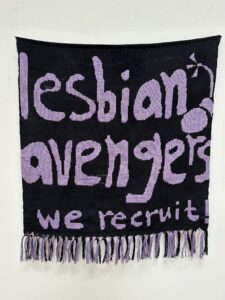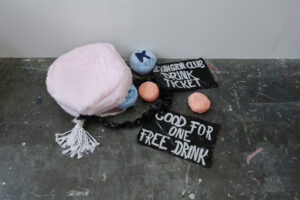3 Dykes Walk into a Bar… by Dani Lopez
January 26, 2024
My current project, 3 Dykes Walk into a Bar…, involves tapestries, embroidered work, and textile sculpture that reveal three characters who are young dykes—coming of age between the 1990s and now. This work unfolds in a non-linear way, reflecting on the chaos and instability of the characters’ experiences.

Dani Lopez, WE RECRUIT!, 2023. Handwoven cotton with double weave pick-up, text is from a protest sign made by The Lesbian Avengers, a 1990s, NYC-based, direct action group that attempted to address the lack of visibility lesbians had throughout the media, 24 x 27.5 inches. Photo by the artist.
The tapestries resemble film stills—acting as excerpts from the characters’ lives. The remnants of their everyday life (the larger sculptural works) alongside these tapestry stills develop their narratives, and show the larger picture of how all my works relate to one another.

Dani Lopez, INTRODUCING EMCEE (feat. the Cheshire Cat, all the Adderall you could ever desire, and a full-blown dissociative breakdown), 2023. Handwoven cotton with film still from Alice and Wonderland, 37 x 21.5 inches. Photo by the artist.
My characters engage and play with certain clichés and stereotypes within the queer community, but ultimately become archetypes within a culture where they do not see themselves reflected. They allude to three very different characters, but they are close friends and are part of a chosen family. I came of age in the 90s in rural Montana and Oregon, and I want this project to reflect the oppressive nature of small towns and the desire to flee to the big city.

Dani Lopez, Hot mess, 2019. Faux fur fabric, satin lining, zipper, faux alligator, cotton, tulle, pleather, crepon, thread, trim, with drink tickets based on tickets from The Lexington Club, the now-closed lesbian bar in San Francisco, dimensions vary. Photo by the artist. Research done at the GLBT Historical Society Archives.
One is the ultimate sad, goth girl (think every Winona Ryder character in the 80s/90s), the other a trickster (akin to the Cheshire Cat), and the vengeful harpy (The Heathers). I use the framework of Lewis Carroll’s Alice in Wonderland as a starting point because it takes you down a deep, drug-induced exploration of space, time, and physical surroundings. This story, or these stories, unfold in a non-linear way that is often the experience of queer folks growing up.

Dani Lopez, It probably didn’t…, 2022. Handwoven cotton with film stills from Requiem for a Dream and Appropriate Behavior, 47 x 20 inches. Photo: Dennis Tyler.
These stories are a blend of my own narrative, people I’ve known and loved, and also several enemies. They reference queer histories that exist between now and a parallel universe. They use a memoir style as a starting point, as well as magical realism to propel the stories forward. While using a blend of cultural research, I also use my own personal experiences, literature, films and poetry made by QTPOC artists, and, more significantly, queer historical moments (like the ACT-UP movement). Looking back to the 80s and 90s to now, I engage with pop culture alongside theory to make the work accessible but also able to stand on its own.

Dani Lopez, 99 Problems (feat. Kid Cudi, Alice, and her flower girls), 2023. Handwoven cotton and wool, with imagery from Alice in Wonderland and text from Kid Cudi’s Soundtrack 2 My Life, 27 x 45 inches. Photo by the artist.
As someone who went to school in my late 20s and came out “late” in my early 30s, my life doesn’t resemble the norm. I’m interested in digging into what it means to exist in a space without a frame of reference for a young queer woman coming up in a culture that often hypersexualizes queer women or renders them invisible.
danilopez.us | @dani___lopez___

Dani Lopez, for donna g., 2019. Handwoven cotton yarn with text from lesbian photographer Donna Gottschalk’s protest sign at the 1970 Christopher Street Gay Liberation Day rally, 24 x 53 inches. Photo by the artist.
